Mealworms are one of the easiest insects to maintain and a common feeder for pet bearded dragons. Darkling beetles (mealworms) are one of over 20,000 species of beetles in the Tenebrionidae (ten-eb-ri-on-i-dea) family (Dellinger and Day, 2018). Mealworms are not worms, they are the larval stage of the darkling beetle, Tenebrio molitor. This is an important distinction because larvae have a high fat content designed to take them through metamorphosis.
The yellow mealworm is also known as false wireworms, darkling beetle and by its formal name Tenebrio molitor L. They are scavengers and omnivores (Dellinger and Day, 2018) eating pretty much anything. In fact, they will even eat polystyrene and plastics (Brandon et al., 2018) which is being researched for its benefits from an environment perspective.

In the wild their diet will include decaying vegetation such as leaves and grasses, feces and grains; decomposing animals and even feces. Some darkling beetles are considered pests. They are very prolific breeders but they have an insurmountable number of predators such as lizards, birds, spiders, rodents and humans to keep them in check.
Mealworm Life cycle
Mealworms go through metamorphosis from eggs to larvae. They then pupate and hatch as beetles. The larva and pupa mealworms can be used to feed bearded dragons.
Eggs
Eggs are elongated in the shape of a tiny bean around 1 to 1.5 mm long. They take between 4 to 19 days for the larvae to hatch from the eggs. Park et al (2014) observed that at 25°C (77°F) eggs hatched after 7 to 8 days whereas Ghaly and Alkoaik (2009) noted a duration of 14 days.
Larvae
The hatched mealworm (larvae) is white and only 2 millimeters long (Singh, 1975; Ghaly and Alkoaik, 2009). The mealworm will reach around 2 to 3.5 cm by the time it is ready to move to pupae stage. Ghaly and Alkoaik (2009) note 2-2.5 cm in length by the time it finishes it larvae stage and Aguilar-Miranda, et al., (2002) observed a size of 2.5 to 3.5 cm with a weight of 0.2 grams (Aguilar-Miranda, et al. 2002).
The larvae goes through a number instars (phase between one molt to another) on its way to the next part of the life cycle (pupa). The number and duration of instars varies.
Tracey (cited by Fiore, 1960) observed that the average lifespan of larvae at 25°C (77°F) was 153.7 days (5 months). Ghaly and Alkoaik (2009) noted the duration of the larval stage as between 182-243 days (6 to 8 months) when provided optimal conditions and this can extend to 2 years in less favorable conditions.
Singh (1975) observed that mealworms went through 9 to 21 instars. Park et al (2014) observed that at 25°C there were between 14 to 20 instars. In addition, Park et al (2014) observed that almost 70% of the mealworms pupated between 15 and 17 instars and that after the 17th instar onward they were underdeveloped, had a high mortality rate and only 1 reached the 20th instar. Ludwig (1956) found that the higher the temperature, the more instars with 25°C averaging 13.2 (12 to 16 instars) and that at 30°C averaging 19.1 (16 to 24 instars).
There are numerous factors that can impact the number of instars which includes:
- parental age. Old parents decrease the duration of the larval stage (Ludwig 1956; Tracey 1958 as cited in Fiore, 1960).
- population density – high is better (Andersen et al., 2017; Connat et al (1991) as cited in Morales-Ramos, 2010)
- humidity (Murray, 1968)
- temperature (Ludwig 1956 cited by Fiore, 1960)
- food quality (Stellwaag-Kittler (1954) cited in Morales-Ramos, 2010)
The first instar takes around 3 to 4 days and thereafter there does not seem to be any consistency between instars of larvae (Park et al, 2014). The more difficult the conditions are, the greater the number of instars.
The mealworms develops its chitinous exoskeleton within days of hatching which turns darker golden and brown color as it matures through the instars.
Before the mealworms pupate they will spend a few days at the surface of the substrate they are living in.
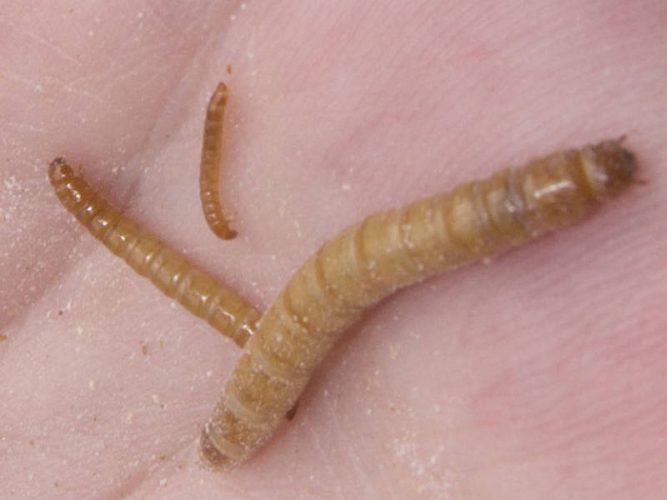
Pupa
When the mealworm is ready to enter pupal stage it moves to the surface (Singh, 1975). The duration of the pupae stage lasts for around 7 days at 25°C (77°F) (Andersen et al, 2017). However, this stage can last up to 9 months if it must go through winter.
Once the pupa has finished its term, it hatches and the darkling beetle emerges.
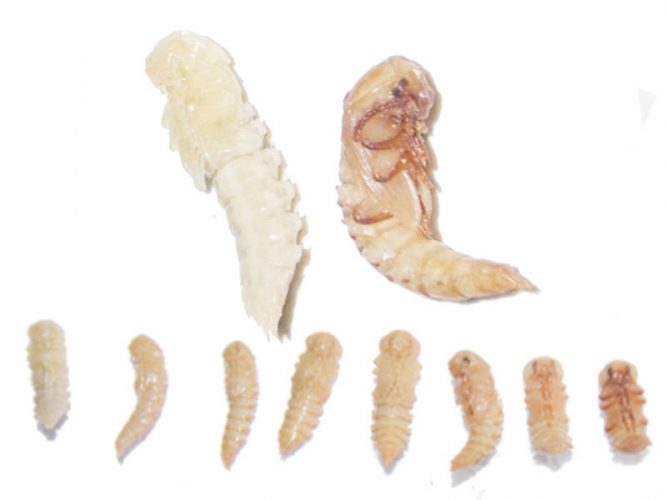
Beetle
The darkling beetle is around 1.25 to 1.8 cm. It starts off with a light cuticle color and within 7 days it goes through to a dark brown/black. The darkling beetle lives for a few months.

Mealworms as a feeder
Are mealworms good or bad as a feeder? Mealworms have their pro’s and con’s as with all feeders. In short, mealworms can be used as a small addition to your bearded dragons diet. Both the pupa and the larva can be fed.
Mealworms can be used as an addition to a bearded dragons diet along with other invertebrates. Moderation in all foods supports providing a wide range of nutrients in the diet. Feeding large quantities of mealworms or exclusively on mealworms causes a deficiency in calcium in chicks (Klasing et al., 2000) and in reptiles may cause metabolic bone disease (MBD) (Brown, 2012). This is frequently raised as a concern by vets around the world for reptiles. For reptiles with MBD, consult your vet before feeding mealworms.
Also worth noting that feeding is an opportunity to stimulate your bearded dragon. Since mealworms are limited to a slow wriggle, they don’t offer your bearded dragon a chance to fully interact with its environment and encourage natural behaviors (more on that in the post on exploring enrichment with accessories).
The Nutrient Value of Mealworms
Mealworm larvae have a high fat content and the low calcium to phosphorous levels. The larval stage of the life cycle has a lot of fat content designed to support it to morph into a beetle.
For humans, mealworms are promoted as being high in nutrients and a viable food source (Vigneron, 2019). When compared with the nutritional value of meats such as beef and chicken, mealworms were shown to provide higher nutritional value (Payne et al, 2016). Finke (cited in Van Huis et al, 2013) compared the nutritional value of mealworms (dry weight, fasted 24 hours) to beef and found:
- the fat content of mealworms is less than beef but beef had slightly higher protein.
- mealworms had higher vitamin content except for B12.
- mealworms had similar potassium, iron, zinc and other minerals.
- numerous variations in amino acids and fatty acids between beef and mealworms.
The main concerns over feeding mealworms are:
- poor calcium to phosphorus ratio
- fat content
- level of chitin
In an analysis on the nutritional value of fresh weight of mealworms performed by Finke (2002) a calcium to phosphorus ratio of 1:17 was recorded. There are great differences in the results of analysis between research which is expected with so many variables that are in play, however none of them produce good results for the calcium to phosphorus ratio.
The recommended ratio of calcium to phosphorus (Ca:P) for omnivores is 1:1.2 for adults and 2:1 for juveniles (Brown, 2012). Dr Amna Ahmad’s recommendation can be seen in the post on Simplifying Calcium and Vitamin D3.
The results of Finke’s (2002) analysis is as follows:
| Stage | Weight (g) | Calcium (mg/kg) | Phosphorus (mg/kg) | Fat |
|---|---|---|---|---|
| Adult beetle | 0.136 | 640 | 7630 | 54 |
| Larva | 0.126 | 440 | 7480 | 134 |
The nutritional composition based on dry matter (Bernard and Allen, 1997):
| Stage | Dry Matter | Calcium | Phosphorus | Ether Extract (Crude Fat) |
|---|---|---|---|---|
| Larva | 37.6% | 0.11% | 0.77% | 52.7% |
| Pupa | 39.0% | 0.08% | 0.83% | 54.6% |
| Beetle | 38.6% | 0.07% | 0.78% | 63.7% |
The nutritional composition of mealworms is directly related to what it is fed. Gut loading has been shown to be able to alter the nutritional value of the mealworm. However, gut loading has its limitations.
Gut Loading Mealworms
Gut loading is filling the gastrointestinal tract with desired nutrients for your bearded dragon. Gut loading mealworms prior to feeding or harvesting them will improve the mealworms nutritional value.
Mealworms can be gut loaded by separating the intended feeders for the next day into a separate substrate enriched with the vitamins and minerals, specifically calcium that is intended for your bearded dragon. The ratio can only be estimated based of research with so many variables and no means to assay your feeders. 24 hours is sufficient for gut loading. Longer may not provide better results and will become fatal to the insects.
There are many studies documenting the value, success and timing of gut loading. For example:
- Latney et al (2017) had success at improving the calcium to phosphorus ratio to 1.3:1 using a calcium cricket diet.
- Klasing et al (2000) added 8% calcium to a broiler mix for chicks with success. Within 24 hours of feeding a calcium supplement to the mealworms (mixed into their substrate) the calcium to phosphorus ratio was improved and available to growing chicks.
- Anderson (2000) successfully increased the calcium to phosphorus ratio in mealworms within 24 hours using calcium fortified commercial diet.
Gorst et al (2015) demonstrated that even when the mealworms where starved for 12 hours, the nutrient value remained so they will sustain the level of calcium in the gut loading for at least one day.
The guidelines for improving mealworms in general to the minimum level is 9 g per 100 g of mealworms, or 9% of the feed in calcium (Mayer, 2014). Remain below 12% calcium. At concentrations of 12% or more it has been shown that mealworms will avoid the food (Mayer, 2014) which negates the exercise.
How many mealworms to feed a bearded dragon
How many mealworms to feed you bearded dragon in a single meal can be calculated as follows:
- Calculation based on juvenile bearded dragon, estimated weight of 150 gm. Juveniles require a relatively high amount of invertebrates, estimating 70% of the diet.
- Total food weight – 5%* of 150 gm is 7.5 gm
- Total invertebrate feeders – 70% of 7.5 gm = 5.25 gm.
- Total mealworm feeders – 20%** of 5.25 gm (total invertebrate feeder weight) = 1.05 gm of mealworms. If the mealworms are at 0.12 gm your juvenile bearded dragon could be fed 8-9 medium mealworms.
- Calculation based on young adult bearded dragon, estimated weight 375 gm. Adults requires a relatively low amount of invertebrates, estimating 20% of the diet.
- Total food weight – 5%* of 375 gm is 18.75 gm.
- Total invertebrate feeders – 20% of 18.75 gm = 3.75 gm.
- Total mealworm feeders – 20%** of the total invertebrate feeder weight = 0.75 gm of mealworms. If the mealworms are at 0.12 gm your adult bearded dragon could be fed 6 medium mealworms.
NOTE: The calculations above assume:
*Diet is 5% of the bearded dragons ideal weight
**Mealworm larvae will not make up no more than 20% of the total invertebrate weight in the diet.
Mealworms are harvested at a young, small age around 0.12 gm.
If you are not actively improving the nutritional value of the mealworms by gut loading then how many you feed your bearded dragon should be reduced. They will be low on calcium and high phosphorus binding important minerals in the diet so that they cannot be used.
Do mealworms cause Impaction in bearded dragons?
There is potential for bearded dragons to be constipated or impacted after eating mealworms.
One of the numerous causes of constipation include feeding large numbers of beetle larvae such as mealworms (Doneley et al, 2017). Bearded dragons are at risk of getting impaction (intestinal obstruction) from eating large amounts of chitin (kite-n) as can be found in the insect exoskeleton such as large mealworms and crickets (Brown, 2012; Doneley et al, 2017).
Dehydration and incorrect temperatures may also play a role in creating unfavorable conditions in the bearded dragon’s body that result in impaction (Brown, 2012).
Chitin is an insoluble fibre (doesn’t dissolve in water) and is present in species such as fungi, algae, crustaceans and insects. Chitin is in the cuticle of mealworms and is soft and flexible allowing it to move freely.
As a matter of interest, chitin is used in a wide range of applications. It has anti-bacterial, anti-viral and anti-fungal properties which make it useful in medical and health care products such as drug capsules, wound healing products and prebiotic. Other applications chitin has also been found to be useful for include wastewater treatment, bioenergy, agriculture and absorbing pollutants (Khoushab and Yamabhai 2010).
To prevent constipation and impaction as a result of eating mealworms:
- keep your bearded dragon hydrated.
- ensure the environment (especially heating and lighting) is set up correctly.
- feed small quantities (see the guide below on how many mealworms to feed your bearded dragon).
Breeding Mealworms
Why should you breed your own mealworms?
When you breed your own mealworms you have total control over the environment including its hygiene. As with any animals, mealworms can have pathogens and parasites which include fungus (Armitage and Siva-Jothy, 2005), protozoa and tapeworms (Vigneron, 2019).
There are concerns over insects purchased commercially for both pets, such as our bearded dragons, and humans alike. In Europe a selection of 75 mealworm farms were examined for parasites by Galecki and Sokol (2019). They detected the farms were infected at the following rates:
- Cryptosporidium spp., in 16%.
- Gregarine spp., in 58.7%.
- Isospora spp., in 9.3% (for more on Isospora see the post on coccidiosis).
- Balantidium spp., including B. coli in 14.7%.
- Entamoeba spp., including E. coli in 12%.
- Tapeworm in 12%.
Galecki and Sokol (2019) also noted some unethical practices which only serve to exacerbate the health issues such as feeding feces from pet shops, dead animals and rotten food. While there is some control on what can be sold for human consumption, pets have no such luxury.
The Mealworm Colony and Reproduction
The density of adults is important for ensuring optimal reproduction (Morales-Ramos et al., 2012). Adult mealworms produce less young when the population density is high. This may not be due to producing less eggs but more because they eat their own eggs when their population is high (Morales-Ramos, 2012). Despite this, the recommended density is high.
The recommended density of adult beetles to attain maximum reproduction output is 8.4 adults per dm2 (Morales-Ramos, 2012). This translates to 1700 beetles or 200 grams of beetles (weighing 0.13 g each) in a container 40 cm wide by 60 cm long for adults (Andersen et al., 2017). Of course, this isn’t so critical when breeding mealworms for your bearded dragon as opposed to commercial purposes.
Mealworm beetles are ready to mate by the 2nd day after emerging from their pupa state although they typically don’t until their 3rd day (Gerber, 2012). The beetles are the most productive at 2 to 3 weeks of age (Morales-Ramos et al., 2012).
Darkling beetles are prolific breeders. The male transfers a packet of semen into the female. In a few day the female will burrow and lay her eggs. The eggs are covered in a sticky secretion which the substrate sticks to (Singh, 1975).
The more the female mates, the more eggs produced. Worden and Parker (2001) observed that mating with different males almost doubled larvae production compared to those mating with the same male.
As with all stages, there is a huge variation in research literature on the number of eggs mealworm beetles produce. Andersen et al (2017) notes female beetles lay 5 to 8 eggs a day adding up to around 300 eggs in her life whereas Ghaly and Alkoaik (2009) note between 250 and 1000 eggs over her lifetime. The variations between research is possibly due to various influencing conditions such as environment of the parents (conducive to increase/decrease the ability to deliver progeny) and cannibalism of the eggs.
Inbreeding has known issues with all species and a compromised immune system is one of the key risks. Inbreeding mealworms will produces smaller beetles and increases the time to develop (Rantala et al., 2011).
There are some natural defenses to protect against inbreeding. Females are attracted to pheromones from outbred males over the pheromones of inbred males (Polkki, 2012). Introducing new mealworm stock to the colony at various stages may reduce the risk of inbreeding.
Males have been found to have no preference when it comes to inbred or outbred females (Polkki, 2012). However, the males do prefer the pheromones of mature, virgin females (Carazo et al (2004) cited in Polkki et al., 2012).
Male pheromones tell the story of the strength of the immune system (Rantala et al (2002) and Rantala et al (2003) cited in Polkki, 2012) and the condition of its body (Rantala et al (2003) cited in Polkki, 2012) impacting how attractive it is to the female. Things that compromise either of these such as a parasitic load, can turn the females off. When males were infected with tapeworm their pheromones were less attractive to females (Worden et al (2000) cited in Polkki, 2012).
The darkling beetles color is directly related to how effective its cuticle is against invasion of pathogens and parasites, particularly its defense against fungal infection. The darker the cuticular (hardened protective covering) color, the thicker it is (Silva et al, 2016) and the better its defenses against pathogens (Evison, 2017; Armitage and Siva-Jothy, 2005; Barnes and Siva-Jothy, 2000).
Since the cuticular color is hereditary (Armitage and Siva-Jothy, 2005) you can improve your colony by weeding out the lighter ones. Removing any mature beetles which have not darkened to the typical black/brown color from the breeding stock will prevent inferior stock breeding and may strengthen of the defenses of the colony.
The pupa has a light casing which does not provide a great deal of protection. The pupa will rotate its abdomen when touched. This little wiggle is a defense mechanism against larva eating it. When Ichikawa and Toshiaki (2009) blocked the nerve enabling that movement the majority of the pupa were killed within 3 days.
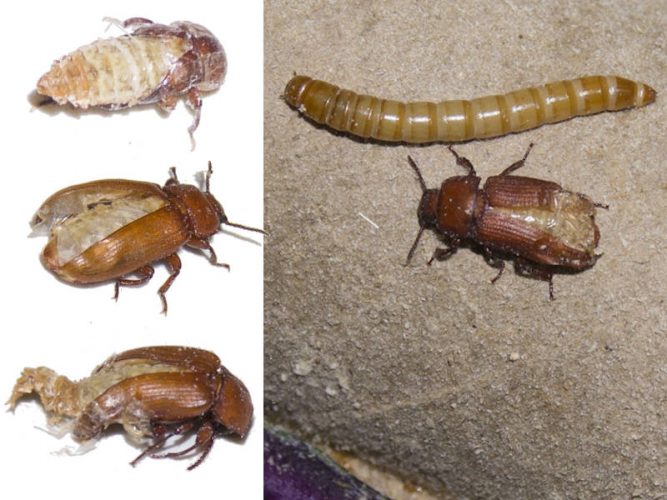
Housing and Heating
Larvae benefit from a high density population. This reduces the distance the larvae must go for fluids and increases their growth (Andersen et al., 2017).
For the housing container provide width over height. Andersen et al (2017) recommends a container size for housing 60 cm long x 40 cm wide x 8-15 cm high for 1700 beetles. Spencer and Spencer (Ed), (2006) recommend a container size of 60 cm long x 45 cm wide x 25 cm high for 1.5-2 kg of larvae.
Andersen et al (2017) also recommends a second container half that size for newly emerged mealworms, moving them to the larger container once they are a month old. The high density will reduce the distance they must go for fluids and increase their growth (Andersen et al., 2017). In addition, the benefits of high density mealworm larva population carries on into adulthood defenses against pathogens. Beetles raised in high density larva population had a better cuticle and as such were less vulnerable to fungus (Barnes and Siva-Jothy, 2000).
Just as with bearded dragons, mealworms are ectotherms, so they depend on their environment. To maximize the health and reproductive potential of the colony it is important to provide the right temperature and humidity.
Optimal relative humidity is 75% although mealworms are able to cope with a wide variation in the humidity from above 50% to 75% with minimal impact when maintained at 25°C (77°F) (Punzo, 1975).
The temperature range for mealworms is 22°C (72°F) to 28°C (82°F) (Punzo, 1975) with optimal conditions at 25°C. The lethal upper temperature is ≥42°C at 24 hours (Altman and Dittmer cited in Punzo, 1975) and chill-coma is induced at 7°-8°C (Altman and Dittmer cited in Punzo, 1975). At higher temperatures the adult mealworm beetle will die quicker and at lower temperatures the young larvae will die quicker (Punzo, 1975).
The optimal temperature for reproduction is 25-27.5°C (77°F-82°F) (Hein and Tracey cited in Fiore, 1960). Punzo (1975) also observed that at 25°C (77°F), with optimal humidity, the oviposition rate will be at its highest. At 35°C (95°F) it drops slightly and at 10°C (50°F) the females will not lay eggs.
Temperature stress is known to impact the immune system of insects and it may extend to the next generation (Vigneron, 2019). Eggert et al (2015) found that when the Red Flour Beetle mothers were subjected to either heat or cold shock the development of the young is slowed.
Mealworms like a dark container. Cover the top of the substrate with layers of paper to keep it dark and this will also encourage the mealworms to make use of all layers of the feeding substrate including the top. If you lift the layers covering the mealworms they will quickly scatter moving away from light. Avoid disrupting them unless you need to.
Watering Mealworms
It is a given that mealworms, like all animals, require water. In mealworms it directly impacts the rapid development of larvae (Ozsoy, 2019; Hopkins, 1973). Water is provided through humidity and a more direct source such as water or vegetation.
Mealworms effectively use water. The faeces are sand like, tiny dry pellets due to the re-absorption of fluids prior to passing (Jurenka (Ed), 2019).
Tenebrio molitor (mealworm) requires humidity to thrive. The mealworm larvae are able to extract moisture from the air (Buxton, 1930; Cloudsley-Thompson, 1964; Mellanby, 1932, 1958 cited in Punzo, 1975). Experiments have found shown that the water content of the body increases or decreases in line with the relative humidity. The ideal conditions for mealworm larvae are 25°C (77°F) and 75% relative humidity.
The amount of water needed by the community is impacted by the humidity of the environment and the type of food provided. For example, Murray (1968) observed that the amount of water required for optimal growth, and even survival, to be offered when feeding wholemeal flour, was lower than when feeding bran. Murray (1968) also noted that the quantity of food eaten decreased with water levels and that low humidity, even when water was available, the mealworms would use their fat reserves as they could not use the food eaten resulting in death.
High humidity will create conditions that encourage other organisms to infect the environment, not the least being fungi. Andersen et al (2017) recommends a relative humidity of 50-70% to balance between providing humidity for optimal growth and reducing the associated risks to the mealworms.
Outside of providing water, fluids are often provided by offering vegetation to mealworms on top of their food. However, as noted by Ozsoy (2019) this can often lead to other organisms growing that have a negative impact on the colony, although so can water. Providing adequate fluids can shorten the larval stage by up to 2 weeks, which is ideal, and water is the best way to do that (Ozsoy, 2019).
Foods with high water content may provide sufficient fluids such as cucumber, watermelon and lettuce. Carrots are often used but they do not provide optimal fluids. An addition of some wet feed such as such as brewery waste was found to be far better on the final outcome than carrots for provisioning water (Andersen et al, 2017).
One major issue with vegetation is the possibility that it is contaminated with pesticides (Spencer and Spencer (Ed), 2006) which could well result in your mealworms dying. Wash any fruits and vegetables prior to offering or remove the skin.
Provide new fruit and vegetables every 2nd day and remove uneaten vegetation each day. For the health of the colony don’t leave vegetation to rot of dry out. Drying out voids their purpose. The mealworms health is important for your pet bearded dragon.
Providing water is ideal and some methods of doing so include providing a diffuser (Ozsoy, 2019) or soaking cotton pads in water.
Feeding Mealworms
The mealworms food is also their substrate. Spencer and Spencer (Ed), 2006) recommend providing a food substrate of:
- 50% bran
- 20% rolled oats
- 5% powdered milk
- 20% fish food
- 5% brewers’ yeast powder
Other diets used successfully in research include:
- Zhang et al (2019) tested a few by-products and compared the nutritional value of the mealworms against those reared on wheat bran. Soybean meal was was one of the three that produced better nutritional results in the mealworms than wheat bran alone.
- Sevana, J. and Jamjanya, T. (2001) used chick diet with wheat bran (1:1) increased the weight of the larvae.
Brewers yeast is a good addition to the mealworm substrate. Davis and Sosulski (cited by Van Broekhoven, 2015) observed that the mealworm doubled its weight when fed 10% brewers yeast (base feed was ground wheat).
Adding shredded cardboard or paper to fine substrates will help add a little more oxygen which is important to the colony health and prevent packing.
As with all animals, hygiene is important, especially with dense populations such as is often with mealworms. Change out the substrate every 7 to 10 days (Spencer and Spencer (Ed), 2006).
Using fine cereal products as opposed to oat flakes makes it easier to separate mealworms from their substrate using sieves. Otherwise picking mealworms out of substrate one by one is tedious.
Freezing the substrate for 2 days prior to placing your mealworms in will help eradicate any pests it may be harboring such as moths. Prevention is best, it is impossible to clean up the substrate once contaminated.
Short term food restriction can halve the effectiveness of the phenoloxidase system (major defense system) which is set back to normal when food is available (Siva-Jothy and Thompson, 2002). For maximum productivity food should not be restricted.
How long do mealworms live in a container?
If you have purchased your bearded dragons mealworms in a small container, they can continue to live in that container for weeks assuming clean food is provided regularly (likely daily in a small container), the frass (poo) is emptied out and water is provided. However, things will get tight as they go through metamorphosis and breed. Hygiene in such a small container and high concentrations of mealworms will become impossible to maintain. If they cannot be used within days then it would be best to follow the guide above on housing mealworms.
Harvesting and Storing mealworms
Mealworms are harvested 7 to 9 weeks after emerging from pupae stage (Andersen et al., 2017). From a weight perspective, Ghaly and Alkoaik (2009) recommend harvesting the mealworms 100-120 mg prior to reaching the last instar where weight is lost.
Keeping mealworms in the Fridge
Do mealworms need to be refrigerated and how long can mealworms last in the fridge? The short answer is yes mealworms can be kept in the fridge however it is not good for them. Mealworms should be used within 5 days after refrigeration before significant losses start.
The temperature of a fridge should be 4°C (40°F) (FDA, 2018). However, mealworms will go into cold coma at +7°C (Punzo & Mutchmor 1980, Jain et al cited in Sonmez and Koc, 2019; Altman and Dittmer cited in Punzo, 1975).
Keeping mealworms in the fridge for long periods of time will result in nervous system failure, muscle damage and deformation over the life cycle stages with the longer the exposure the greater the changes (Sonmez and Koc, 2019). Sonmez and Koc (2019) observed that when kept in temperatures of 2°C during the pupal stage for 15 days, 75% died, many did not emerge and those that did had a high rate of deformity. The deformity rate rose significantly after 5 days.
Punzo (1975) observed that when mealworms were kept at 10°C (well above fridge temperature) with a relative humidity between 52% to 75 % that there were no losses, or the losses were negligible for old larvae (over 100 mg), pupae and adults up to 48 hours. However, young larvae (under 30 mg) will begin dying within 6 hours at 52% relative humidity and 24 hours at 75% relative humidity.
Sonmez and Koc (2019) recommend that mealworms are not suitable for refrigeration dependent on the use of the insect. For pet bearded dragon mealworms can be kept in a fridge. However, for the health of the mealworms (their quality impacts your bearded dragon), keep them in the fridge no longer than 5 days before using the entire stock to avoid high mortality rate.
If there is a need to keep the mealworms in the fridge longer than 5 days remove them from the fridge for 24 hours, feed and water them and then return them to the fridge again.
How to Freeze Mealworms for Bearded Dragon Feed
Yes you can freeze mealworms. As per Andersen et al., (2017) the steps to harvesting mealworms for storage are:
- If the gut content of the mealworm is to be cleared before freezing then store the mealworms at 15°C (59°F) for 1 day. This will allow them to pass their gut content. If you have gut loaded the mealworms to add to their nutritional content then skip this step.
- Freeze the mealworms at -18°C (0°F) for 2 days. -18°C (0°F) is the temperature your freezer should be set to (FDA, 2018).
Keep the mealworms in an airtight bag in the freezer until you are ready to feed them to your bearded dragon.
Other Posts
References
- Aguilar-Miranda, E. Ed., Lopez, M. G., Escamilla-Santana, C., and De La Rosa, B.A.P. (2002) Characteristics of maize flour tortilla supplemented with ground Tenebrio molitor Larvae. Journal of Agricultural and Food Chemistry, 50: 192-195. https://doi.org/10.1021/jf010691y
- Andersen, J. L., Berggreen, I. E., and Heckmann, L. L. (2017) Recommendations for breeding and holding of regular mealworm, Tenebrio molitor. Prepared for INBIOM – Danish Insect Network and inVALUABLE. Prepared by Insect Group, Water and Environment.
- Anderson, S. J. (2000) Increasing calcium levels in cultured insects. Zoo Biology 19(1): 1-9 https://doi.org/10.1038/sj.hdy.6800675
- Barnes, A., and Siva-Jothy,M. (2000) Density-dependent prophylaxis in the mealworm beetle Tenebrio molitor L. (Coleoptera: Tenebrionidae): Cuticular melanization is an indicator of investment in immunity. Proceedings. Biological sciences / The Royal Society. 267: 177-82. https://doi.org/10.1098/rspb.2000.0984.
- Bernard, J. B. and Allen, M. E. Ed: Ullrey, D. E. (1997) Feeding Captive Insectivorous Animals: Nutritional Aspects of Insects as Food. Nutritional Advisory Group Handbook
- Brandon A. M., Gao S., Tian R., Ning D., Yang S., Zhou J., Wu, W., and Criddle, C. S. (2018). Biodegradation of polyethylene and plastic mixtures in mealworms (larvae of Tenebrio molitor) and effects on the gut microbiome. Environmental Science and Technology. 52 (11): 6526–6533. https://doi.org/10.1021/acs.est.8b02301
- Brown, D. BVSc (Hons) BSc (Hons) (2012) A Guide to Australian Dragons in Captivity. Reptile Publications, QLD.
- Dellinger, T. A. and Day, E. R. (2018) Darkling Beetles and Mealworms. Virginia State University.
- Doneley, B., Monks, D., Johnson, R., and Carmel, B. (2017) Reptile Medicine and Surgery in Clinical Practice. John Wiley & Sons Ltd, West Sussex.
- Eggert, H., Diddens-de Buhr, M. F., & Kurtz, J. (2015). A temperature shock can lead to trans-generational immune priming in the Red Flour Beetle, Tribolium castaneum. Ecology and evolution, 5(6): 1318–1326. https://doi.org/10.1002/ece3.1443
- Evison, S. E., Gallagher, J. D., Thompson, J. J., Siva-Jothy, and M. T., Armitage, S. A. (2017) Cuticular colour reflects underlying architecture and is affected by a limiting resource. Journal of Insect Physiol 98: 7–13.
- Finke, M. D. (2002) Complete Nutrient Composition of Commercially Raised Invertebrates Used as Food for Insectivores. Zoo Biology 21 pp 269–285
- Fiore, C. (Mar., 1960) Effects of Temperature and Parental Age on the Life Cycle of the Dark Mealworm, Tenebrio obscurus fabricius. Journal of the New York Entomological Society. 68 (1), pp. 27-35
- FDA. (2018) Are you Storing Food Safely? https://www.fda.gov/consumers/consumer-updates/are-you-storing-food-safely
- Gałęcki, R. and Sokół, R. (2019) A parasitological evaluation of edible insects and their role in the transmission of parasitic diseases to humans and animals PLOS ONE 14(7): e0219303 https://doi.org/10.1371/journal.pone.0219303
- Gerber, G. (1973). Reproductive Behaviour and Physiology of Tenebrio molitor (Coleoptera : Tenebrionidae) : I. Initiation of Mating in Young Adults and the Effects of Adult Density. The Canadian Entomologist, 105(5), 807-811. https://doi.org/10.4039/Ent105807-5
- Ghaly, A. E., and Alkoaik, F. (2009) The Yellow Mealworm as a Novel Source of Protein. American Journal of Agricultural and Biological Science. 4. https://doi.org/10.3844/ajabssp.2009.319.331
- Gorst, V.M., Mitchell, K. and Whitehouse-Tedd, K. M. (2015) Effect of post-gut loading time on the macro-nutrient content of three feeder invertebrate species. Journal of Zoo and Aquarium Research. 3(3)
- Hopkins, T. L. (Mar, 1973) Effect of moisture on growth rate and development of two strains of Tenebrio molitor L. (Coleoptera, Tenebrionidae) Journal of Stored Products Research. 8(4) p 291-297 https://doi.org/10.1016/0022-474X(73)90045-3
- Ichikawa, T., & Toshiaki, K. (2009) Larval Cannibalism and Pupal Defense Against Cannibalism in Two Species of Tenebrionid Beetles. Zoological science. 26. pp 525-9. https://doi.org/10.2108/zsj.26.525.
- Jurenka, R (Ed) (2019) Advances in Insect Physiology, Volume 56. Academic Press, London UK.
- Khoushab, F., and Yamabhai, M. (2010). Chitin research revisited. Marine drugs, 8(7), 1988–2012. https://doi.org/10.3390/md8071988
- Klasing, K. C., Thacker, P., Lopez, M. A., and Calvert, C. C. (Dec, 2000) Increasing the calcium content of mealworms (Tenebrio molitor) to improve their nutritional value for bone mineralization of growing chicks. Journal of Zoo and Wildlife Medicine. 31(4): 512-7. https://doi.org/10.1638/1042-7260(2000)031[0512:ITCCOM]2.0.CO;2
- Ludwig, D. (1956) Effects of temperature and parental age on the life cycle of the mealworm, Tenebrio molitor Linnaeus (Coleoptera: Tenebrionidae). Annals of the Entomological Society of America 49(1): 12-15.
- Makkar, H. P. S., Tran, T., Heuzé, V., and Ankers, P. (Nov, 2014) State-of-the-art on use of insects as animal feed Animal Feed Science and Technology. 197: 1-33 https://doi.org/10.1016/j.anifeedsci.2014.07.008
- Mayer, J. (Ed: Rupley, A. E.) (2014) Nutrition. Veterinary Clinics of North America: Exotic Animal Practice. 17(3). Elsevier
- Morales-Ramos, J. A., Rojas, M. G., Kay, S., Shapiro-Ilan, D. I., and Tedders, W. L. (2012) Impact of Adult Weight, Density, and Age on Reproduction of Tenebrio molitor (Coleoptera: Tenebrionidae). Journal Entomology Science. 47(3): 208-220
- Murray, D. R. P. (June, 1968) The Importance of Water in the Normal Growth of Larvae of Tenebrio molitor. Entomologia Experimentalis et Applicata. 11(2): 149-168 https://doi.org/10.1111/j.1570-7458.1968.tb02041.x
- Ozsoy, A. N. (2019) Modeling of development and water consumption of mealworm, Tenebrio molitor L., 1758 (Coleoptera: Tenebrionidae) larvae using nonlinear growth curves and polynomial functions. Türk. entomol. derg., 43(3) p 253-262 http://dx.doi.org/10.16970/entoted.487815
- Park, Jong Bin, Choi, Wonho, Kim, Seong Hyeon, Jin, Hyo Jung, Han, Yeon-Soo, 이용석, & Kim, Nam-Jeong. (2014). Developmental characteristics of Tenebrio molitor larvae (Coleoptera: Tenebrionidae) in different instars. International Journal of Industrial Entomology, 28(1): 5–9. https://doi.org/10.7852/IJIE.2014.28.1.5
- Payne, C. L., Scarborough, P., Rayner, M., and Nonaka, K. (2016) Are edible insects more or less “healthy” than commonly consumed meats? A comparison using two nutrient profiling models developed to combat over- and undernutrition. European Journal of Clinical Nutrition 70:285–91.
- Polkki, M., Krams, I., Kangassalo, K., and Rantala, M. J. (2012) Inbreeding affects sexual signalling in males but not females of Tenebrio molitor. Biology Letters 8(3): 423–425. https://doi.org/10.1098/rsbl.2011.1135
- Punzo, F. (1975) Effects of Temperature, Moisture and Thermal Acclimation on the Biology of Tenebrio molitor (Coleoptera : Tenebrionidae) Doctoral dissertation Doctor of Philosophy. Iowa State University
- Rantala, M., Viitaniemi, Hlk and Roff, D. (2011) Effects of inbreeding on potential and realized immune responses in Tenebrio molitor. Parasitology, 138(7): 906-912. https://doi.org/10.1017/S0031182011000473
- Sevana, J. and Jamjanya, T. (2001) Industrial mass rearing of mealworm beetle (Tenebrio molitor L.) 29(4) pp 194-200 Thai National AGRIS Centre
- Silva, F. W. S., Araujo, L. S., Azevedo, D. O., Serrão, J. E., and Elliot, S. L. (2016) Physical and chemical properties of primary defences in Tenebrio molitor. Physiol Entomol 41:121–6.
- Singh, P. (1975) Yellow mealworm, Tenebrio molitor Linnaeus, life-cycle. Department of Scientific and Industrial Research https://doi.org/10.7931/DL1-DIS-105-13
- Siva-Jothy, M. T., and Thompson, J. J. W. (2002) Short‐term nutrient deprivation affects immune function. Physiological Entomology 27: 206–212. https://doi.org/10.1046/j.1365-3032.2002.00286.x
- Sonmez, E. and Koc, Y. (2019) Effects of cold exposure on Tenebrio molitor (Coleoptera: Tenebrionidae) pupal period, proportion of adult emergence, weight and deformation percentage. Entomologica Fennica, 30(1): 43-48. https://doi.org/10.33338/ef.79905
- Spencer, S. (Ed), and Spencer, J. (Ed). (2006) Management Guideline Manual for Invertebrate Live Food Species. European Association of Zoos and Aquaria Terr. Invertebr. TAG 1-54
- Van Broekhoven, S. (2015) Quality and safety aspects of mealworms as human food. PhD thesis, Wageningen University, NL
- Van Huis, A., Van Itterbeeck, J., Klunder, H., Mertens, E., Halloran, A., Muir, G., and Vantomme, P. (2013). Edible insects: future prospects for food and feed security. 6: Nutritional values of insects for human consumption
- Vigneron, A., Jehan, Charly., Rigaud, Thierry., and Moret, Y. (2019) Immune Defenses of a Beneficial Pest: The Mealworm Beetle, Tenebrio molitor. Frontiers in Physiology. Invertebrate Physiology. https://doi.org/10.3389/fphys.2019.00138
- Worden, B. D., and Parker, P. G. (2001) Polyandry in grain beetles, Tenebrio molitor, leads to greater reproductive success: material or genetic benefits? Behavioral Ecology. 12(6): 761–767, https://doi.org/10.1093/beheco/12.6.761
- Zhang, X., Tang, H., Chen, G., Qiao, L., Li, J., Liu, B., Liu, Z., Li, M., and Liu, X. (2019). Growth performance and nutritional profile of mealworms reared on corn stover, soybean meal, and distillers’ grains. European Food Research and Technology. https://doi.org/10.1007/s00217-019-03336-7.


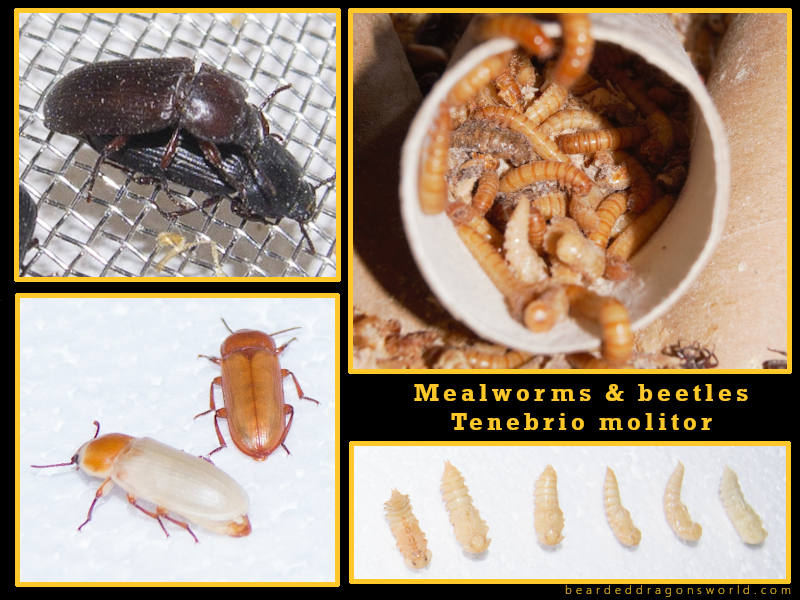
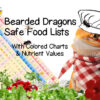
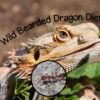


Kudos to the author!
What an amazing amount of research compiled here. Thank you so much.
Could you please review the temperatures for refrigeration and freezing at the end of the article? They don’t seem right to me.
Kind regards
Klara
Great pick up thanks Klara! I didn’t notice the missing minus sign in the Fahrenheit freezer temperatures until you said that! All fixed, much appreciated.